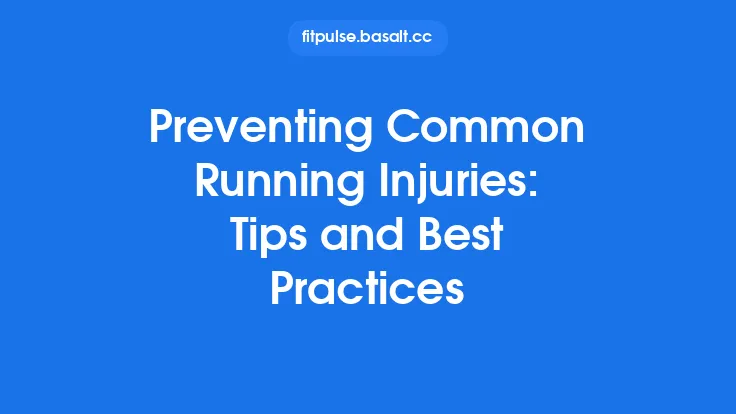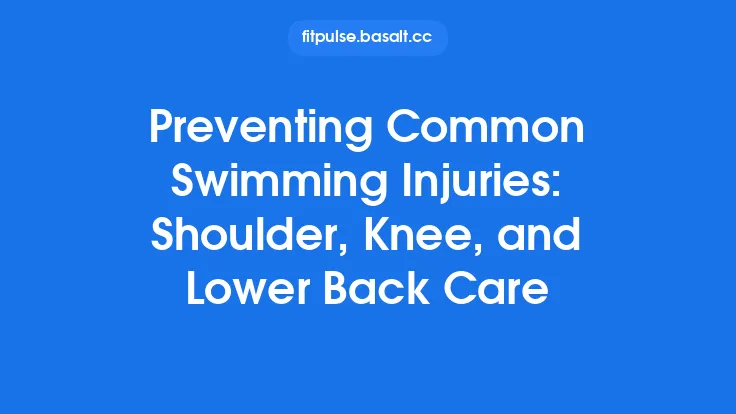Cycling is a low‑impact, high‑reward sport that can be enjoyed year‑round, but the repetitive nature of pedaling, long hours in the saddle, and exposure to varying terrain and weather can lead to a range of injuries if proper precautions aren’t taken. This evergreen guide walks you through the most common cycling‑related ailments, explains why they happen, and offers practical, evidence‑based strategies for preventing and managing them. Whether you’re a weekend enthusiast, a club rider, or a seasoned triathlete, the information below will help you stay healthy, ride longer, and enjoy the sport with confidence.
Understanding the Most Common Cycling Injuries
| Injury | Typical Causes | Primary Symptoms |
|---|---|---|
| Patellofemoral Pain Syndrome (PFPS) | Repetitive knee flexion, poor pedal stroke mechanics, excessive saddle height | Dull ache around the kneecap, especially on climbs or after long rides |
| Iliotibial (IT) Band Syndrome | Friction of the IT band over the lateral femoral epicondyle, especially on uneven surfaces | Sharp pain on the outer knee, worsening with sustained effort |
| Lower Back Strain | Prolonged flexed posture, weak core, sudden jolts from rough terrain | Aching or stabbing pain in the lumbar region, sometimes radiating to the glutes |
| Neck and Shoulder Tension | Forward head position, gripping the handlebars too tightly, inadequate bike reach | Tightness, stiffness, or tingling in the neck, shoulders, and upper back |
| Saddle Sores & Perineal Irritation | Prolonged pressure, friction, moisture, and poor hygiene | Red, inflamed skin, sometimes with ulceration or a burning sensation |
| Numbness (Nerve Compression) | Pressure on the ulnar nerve (hands) or pudendal nerve (perineum) from improper grip or saddle design | Tingling, numbness, or “pins‑and‑needles” in the hands, fingers, or genital area |
| Foot & Ankle Issues (e.g., metatarsalgia, Achilles tendinopathy) | Stiff cleats, improper shoe fit, excessive ankle dorsiflexion | Pain in the ball of the foot, heel, or Achilles region, especially after climbs |
| Wrist Pain (Carpal Tunnel, De Quervain’s) | Over‑gripping, prolonged vibration, poor wrist alignment | Numbness, tingling, or aching in the thumb, index, and middle fingers |
Understanding the root cause of each problem is the first step toward effective prevention and treatment.
Key Principles of Injury Prevention
- Gradual Progression – Increase mileage, intensity, or terrain difficulty by no more than 10 % per week. Sudden spikes overload musculoskeletal structures.
- Balanced Training Load – Alternate hard days with easy rides or active recovery to allow tissue remodeling.
- Adequate Rest – Incorporate at least one full rest day per week and schedule periodic “cut‑back” weeks (reduced volume) every 3–4 weeks.
- Mobility & Flexibility – Regular dynamic warm‑ups and post‑ride static stretches maintain joint range of motion and reduce muscle tightness.
- Strength & Stability – Targeted exercises for the glutes, core, hips, and upper body improve force transfer and protect vulnerable joints.
- Equipment Hygiene – Keep the saddle, handlebars, and shoes clean and dry; replace worn pads and insoles promptly.
- Environmental Awareness – Adjust riding style for heat, cold, or rough surfaces to avoid over‑exertion and impact‑related injuries.
Ergonomic Considerations for Comfort and Safety
While a full bike‑fit analysis belongs in a dedicated guide, a few ergonomic tweaks can dramatically lower injury risk:
- Saddle Height – When seated, your leg should have a slight bend (≈25–30°) at the knee at the bottom of the pedal stroke. Too high stresses the hip flexors; too low overloads the knee.
- Saddle Tilt – A neutral (level) saddle prevents excessive pressure on the perineum. Small adjustments (±2°) can alleviate numbness.
- Handlebar Reach – Aim for a relaxed shoulder position with elbows slightly bent. Over‑reaching forces the spine into a hyper‑flexed posture, increasing lower‑back strain.
- Grip Width – Hands should sit comfortably on the drops or flat bars without forcing the wrists into extreme extension or ulnar deviation.
- Cleat Position – Align the ball of the foot over the pedal axle; fore‑to‑aft placement influences knee tracking and ankle dorsiflexion.
Small, incremental changes—tested over a few rides—can make a big difference without a full professional fitting.
Warm‑Up, Mobility, and Stretching Routines
A structured warm‑up primes the neuromuscular system and prepares connective tissue for the repetitive loads of cycling.
Dynamic Warm‑Up (10–15 min)
- Leg Swings – Front‑to‑back and side‑to‑side (10 each leg) to mobilize the hip joint.
- Hip Circles – Standing or on all fours, rotate hips clockwise and counter‑clockwise (10 each direction).
- Arm Circles & Shoulder Rolls – Large circles (10 forward, 10 backward) to loosen the shoulder girdle.
- High Knees or Marching – 30 seconds to increase heart rate and activate the quadriceps.
- Ankle Pumps – Flex and point the feet (15 each) to prime the Achilles tendon and calf muscles.
Post‑Ride Stretching (5–10 min)
- Quadriceps Stretch – Standing, pull the heel toward the glutes, hold 30 seconds each side.
- Hamstring Stretch – Seated or standing, hinge at the hips, keep the back straight, hold 30 seconds each side.
- Hip Flexor Stretch – Lunge position, gently push hips forward, hold 30 seconds each side.
- Chest & Upper‑Back Stretch – Interlace fingers behind the back, lift arms, hold 30 seconds.
- Forearm Stretch – Extend arm, pull fingers back with the opposite hand, hold 20 seconds each side.
Consistency with these routines reduces muscle stiffness, improves joint range, and lowers the likelihood of overuse injuries.
Targeted Strength and Conditioning for Injury Resilience
Even without a full strength‑conditioning program, incorporating a few key exercises 2–3 times per week can protect the most injury‑prone areas.
| Muscle Group | Exercise | Sets × Reps | Notes |
|---|---|---|---|
| Glutes & Hip Abductors | Clamshells (band) | 3 × 15 each side | Strengthens the gluteus medius, stabilizing the knee. |
| Single‑Leg Bridge | 3 × 12 each leg | Emphasizes hip extension and posterior chain activation. | |
| Core | Pallof Press (band) | 3 × 10 each side | Anti‑rotation work protects the lumbar spine. |
| Bird‑Dog | 3 × 12 each side | Improves lumbar stability and coordination. | |
| Quadriceps | Wall Sit (static) | 3 × 45 s | Builds endurance without excessive joint loading. |
| Upper Back & Shoulders | Scapular Retractions (band) | 3 × 15 | Counters forward‑rounded posture from prolonged handlebar time. |
| Forearms & Grip | Farmer’s Carry (light dumbbells) | 3 × 30 s | Enhances grip endurance, reducing excessive hand pressure. |
Progress slowly, focusing on form rather than weight. These movements address muscular imbalances that often underlie cycling injuries.
Managing Acute Injuries: First‑Aid and Immediate Care
When an injury occurs, prompt and appropriate action can limit tissue damage and speed recovery.
- R.I.C.E. (Rest, Ice, Compression, Elevation)
- Rest – Cease cycling and any aggravating activity.
- Ice – Apply a cold pack (0–15 °C) for 15–20 minutes, 2–3 times daily, for the first 48 hours.
- Compression – Use elastic wraps or sleeves to reduce swelling, especially for knee or ankle sprains.
- Elevation – Keep the injured limb above heart level when possible.
- Pain Management
- Over‑the‑counter NSAIDs (e.g., ibuprofen) can reduce inflammation, but use them sparingly and follow dosage guidelines.
- Protective Gear
- For hand or wrist injuries, consider padded gloves or a wrist brace during the early healing phase.
- Early Mobilization
- Gentle range‑of‑motion exercises (e.g., ankle circles, finger flexion) prevent stiffness, provided they do not exacerbate pain.
If symptoms persist beyond a few days, or if you notice swelling, bruising, or loss of function, seek professional evaluation.
Rehabilitation Strategies for Specific Injuries
Patellofemoral Pain Syndrome (PFPS)
- Phase 1 (Pain Control) – R.I.C.E., NSAIDs, and short bouts of stationary cycling with low resistance (5–10 minutes) to maintain joint motion.
- Phase 2 (Strengthening) – Quadriceps setting, straight‑leg raises, and wall sits progressing to step‑downs and single‑leg squats.
- Phase 3 (Neuromuscular Control) – Lateral step‑ups, mini‑band lateral walks, and controlled lunges.
- Return to Riding – Gradual re‑introduction of hills, monitoring pain during and after rides.
Iliotibial Band Syndrome
- Foam‑Rolling – Roll the lateral thigh from the glute to the knee for 2 minutes daily.
- Hip Abductor Strength – Side‑lying leg lifts, clamshells, and banded monster walks.
- Stretching – Standing IT‑band stretch (cross one leg behind the other, lean opposite side) for 30 seconds each side.
Lower Back Strain
- Core Activation – Bird‑dog, dead‑bug, and plank variations (front and side) to build lumbar stability.
- Flexibility – Hip flexor and hamstring stretches to reduce anterior pelvic tilt.
- Post‑Ride Recovery – Gentle lumbar extensions on a stability ball or cat‑cow yoga flow.
Saddle Sores & Perineal Irritation
- Hygiene – Clean the saddle area with mild antiseptic after each ride; change padded shorts regularly.
- Pressure Relief – Use a cut‑out or gel‑filled saddle; consider a noseless design for severe perineal compression.
- Topical Care – Apply a barrier ointment (e.g., zinc oxide) and, if needed, an antimicrobial cream.
Numbness (Hand or Perineal)
- Grip Adjustments – Alternate hand positions (drops, tops, hoods) every 20–30 minutes.
- Glove Choice – Padded, breathable gloves reduce pressure on the ulnar nerve.
- Saddle Tilt – Slightly nose‑up tilt can alleviate perineal compression; test small increments.
Foot & Ankle Issues
- Cleat Alignment – Ensure the fore‑to‑aft cleat position aligns the ball of the foot over the pedal axle.
- Shoe Fit – Allow a thumb’s width of space at the toe box; replace worn insoles.
- Ankle Mobility – Calf stretches and ankle dorsiflexion drills (e.g., wall ankle mobilizations).
When to Seek Professional Help
| Situation | Recommended Professional |
|---|---|
| Persistent pain > 2 weeks despite self‑care | Sports physiotherapist or orthopedic specialist |
| Swelling, bruising, or instability after a fall | Emergency department or urgent care |
| Numbness that does not resolve after adjusting position | Neurologist or physiatrist |
| Chronic saddle sores with signs of infection (redness, pus) | Primary care physician or dermatologist |
| Recurrent injuries despite corrective measures | Certified bike‑fit specialist (for ergonomic reassessment) |
Early intervention often prevents a minor issue from becoming a chronic problem.
Long‑Term Strategies for Sustainable Cycling Health
- Periodically Re‑Assess Bike Setup – Even small changes in flexibility, weight, or riding style can necessitate adjustments.
- Integrate “Active Recovery” Days – Light spin sessions (30–45 minutes at < 50 % FTP) promote blood flow without stressing tissues.
- Track Pain and Load – Use a simple log (e.g., spreadsheet or app) to note any discomfort, ride volume, and recovery quality. Patterns can reveal early warning signs.
- Maintain General Fitness – Incorporate low‑impact cross‑training (e.g., swimming, rowing) only if it complements injury prevention goals, not as a primary focus.
- Prioritize Sleep and Hydration – Both are essential for tissue repair and pain modulation, even though they fall outside the scope of dedicated recovery protocols.
Seasonal and Environmental Considerations
- Heat – Sweat increases friction; use moisture‑wicking shorts and apply anti‑chafing powders. Hydration helps prevent muscle cramps that can lead to compensatory injuries.
- Cold – Muscles and tendons become less pliable; perform a longer warm‑up and consider thermal leggings to maintain tissue temperature.
- Rain & Mud – Wet handlebars increase grip pressure, potentially aggravating hand numbness. Use gloves with good water resistance and consider a slightly wider handlebar grip.
- Off‑Road Terrain – Rough surfaces amplify vibration; a suspension seatpost or wider tires can reduce impact on the lower back and perineum.
Adapting your routine to the environment reduces the cumulative stress placed on vulnerable structures.
Building an Injury‑Prevention Checklist
| Checklist Item | Frequency | How to Verify |
|---|---|---|
| Saddle height & tilt | Every 4–6 weeks or after major fitness changes | Perform the heel‑on‑pedal test; check for perineal pressure after a 1‑hour ride |
| Handlebar reach | Quarterly | Ensure elbows are slightly bent; shoulders relaxed |
| Cleat alignment | Monthly or after new shoes | Verify foot position on the pedal; watch for knee tracking issues |
| Glove & shoe condition | Every ride | Inspect for wear, replace when padding degrades |
| Warm‑up completion | Pre‑ride | Log 10‑minute dynamic routine |
| Post‑ride stretch | Post‑ride | Record stretches performed and duration |
| Pain log | Daily | Note any new or lingering discomfort |
| Strength session | 2–3 times/week | Track completed exercises and progression |
| Rest day | Weekly | Confirm at least one full day without structured training |
Reviewing this checklist before each training block helps embed preventive habits into your cycling routine.
Final Thoughts
Cycling’s repetitive motion and prolonged seated position make it uniquely prone to overuse injuries, but with a systematic approach—grounded in proper ergonomics, targeted conditioning, diligent warm‑up and cool‑down practices, and early injury management—you can dramatically reduce risk and enjoy a longer, healthier riding career. Remember that prevention is an ongoing process: stay attuned to your body, adjust your equipment as needed, and don’t hesitate to seek professional guidance when the usual remedies aren’t enough. By integrating the strategies outlined above, you’ll build a resilient foundation that supports both everyday rides and ambitious training goals alike. Happy cycling!





